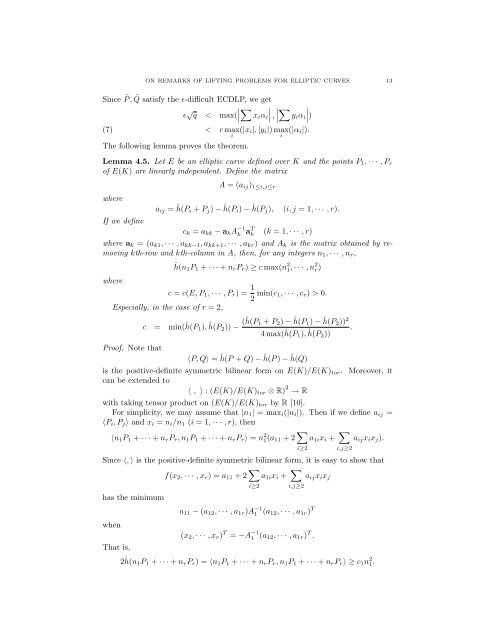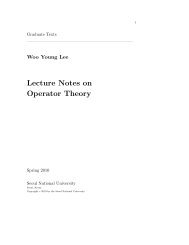ON REMARKS OF LIFTING PROBLEMS FOR ELLIPTIC CURVES 1 ...
ON REMARKS OF LIFTING PROBLEMS FOR ELLIPTIC CURVES 1 ...
ON REMARKS OF LIFTING PROBLEMS FOR ELLIPTIC CURVES 1 ...
Create successful ePaper yourself
Turn your PDF publications into a flip-book with our unique Google optimized e-Paper software.
<strong>ON</strong> <strong>REMARKS</strong> <strong>OF</strong> <strong>LIFTING</strong> <strong>PROBLEMS</strong> <strong>FOR</strong> <strong>ELLIPTIC</strong> <strong>CURVES</strong> 13<br />
Since ˜P , ˜Q satisfy the ɛ-difficult ECDLP, we get<br />
ɛ √ ∣<br />
∑ ∣ ∣ ∣∣ ∣∣ ∑ ∣ ∣∣)<br />
q < max(<br />
xi α i , yi α i<br />
(7)<br />
< r max<br />
i<br />
The following lemma proves the theorem.<br />
(|x i |, |y i |) max(|α i |).<br />
Lemma 4.5. Let E be an elliptic curve defined over K and the points P 1 , · · · , P r<br />
of E(K) are linearly independent. Define the matrix<br />
where<br />
A = (a ij ) 1≤i,j≤r<br />
a ij = ĥ(P i + P j ) − ĥ(P i) − ĥ(P j),<br />
i<br />
(i, j = 1, · · · , r).<br />
If we define<br />
c k = a kk − a k A −1<br />
k aT k (k = 1, · · · , r)<br />
where a k = (a k1 , · · · , a kk−1 , a kk+1 , · · · , a kr ) and A k is the matrix obtained by removing<br />
kth-row and kth-column in A, then, for any integers n 1 , · · · , n r ,<br />
ĥ(n 1 P 1 + · · · + n r P r ) ≥ c max(n1, 2 · · · , nr)<br />
2<br />
where<br />
Especially, in the case of r = 2,<br />
Proof. Note that<br />
c = c(E, P 1 , · · · , P r ) = 1 2 min(c 1, · · · , c r ) > 0.<br />
c = min(ĥ(P 1), ĥ(P 2)) − (ĥ(P 1 + P 2 ) − ĥ(P 1) − ĥ(P 2)) 2<br />
4 max(ĥ(P 1), ĥ(P .<br />
2))<br />
〈P, Q〉 = ĥ(P + Q) − ĥ(P ) − ĥ(Q)<br />
is the positive-definite symmetric bilinear form on E(K)/E(K) tor . Moreover, it<br />
can be extended to<br />
〈 , 〉 : (E(K)/E(K) tor ⊗ R) 2 → R<br />
with taking tensor product on (E(K)/E(K) tor by R [10].<br />
For simplicity, we may assume that |n 1 | = max i (|n i |). Then if we define a ij =<br />
〈P i , P j 〉 and x i = n i /n 1 (i = 1, · · · , r), then<br />
〈n 1 P 1 + · · · + n r P r , n 1 P 1 + · · · + n r P r 〉 = n 2 1(a 11 + 2 ∑ a 1i x i + ∑<br />
a ij x i x j ).<br />
i≥2<br />
i,j≥2<br />
Since 〈, 〉 is the positive-definite symmetric bilinear form, it is easy to show that<br />
f(x 2 , · · · , x r ) = a 11 + 2 ∑ a 1i x i + ∑<br />
a ij x i x j<br />
i≥2<br />
i,j≥2<br />
has the minimum<br />
when<br />
That is,<br />
a 11 − (a 12 , · · · , a 1r )A −1<br />
1 (a 12, · · · , a 1r ) T<br />
(x 2 , · · · , x r ) T = −A −1<br />
1 (a 12, · · · , a 1r ) T .<br />
2ĥ(n 1P 1 + · · · + n r P r ) = 〈n 1 P 1 + · · · + n r P r , n 1 P 1 + · · · + n r P r 〉 ≥ c 1 n 2 1.













